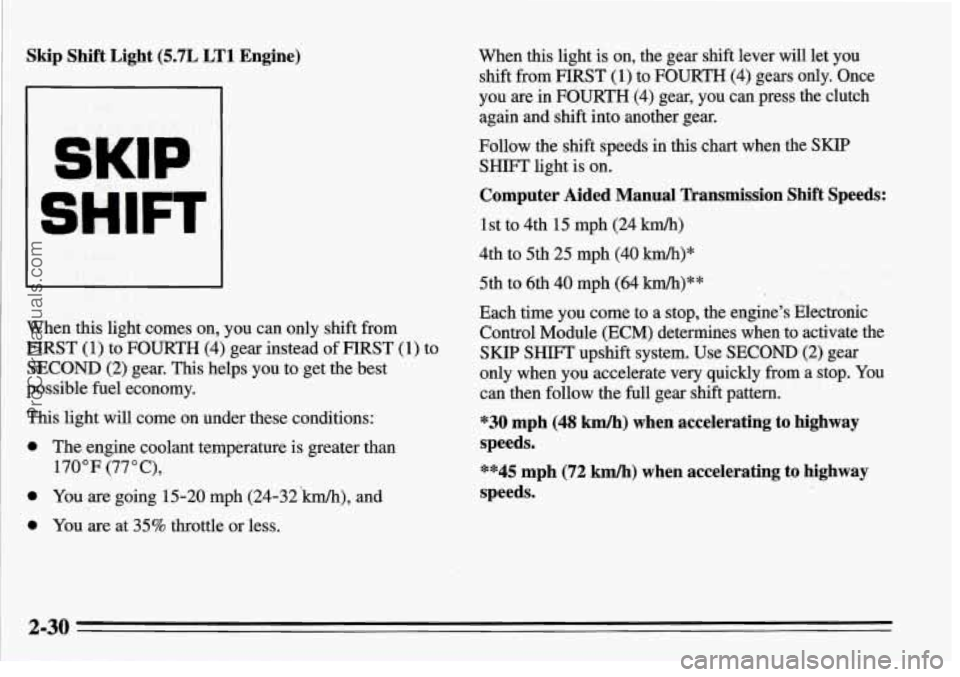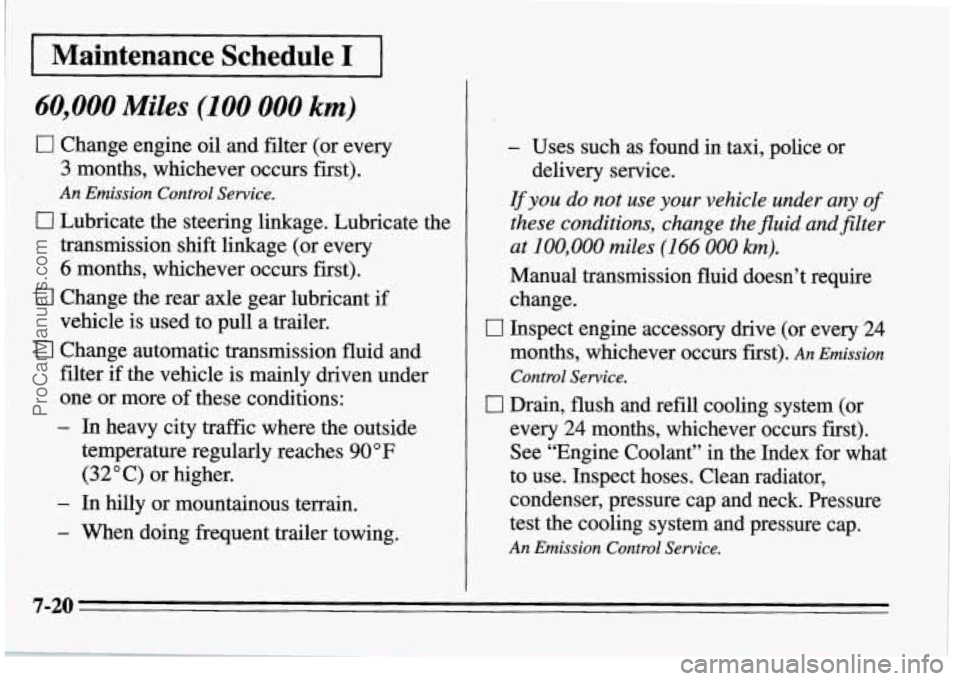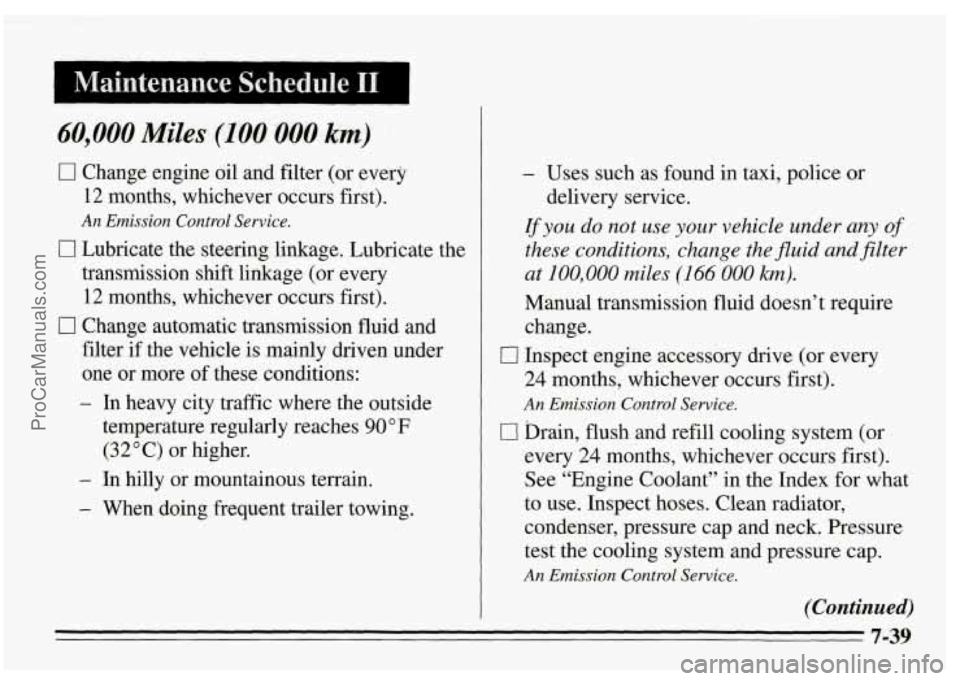coolant temperature PONTIAC FIREBIRD 1995 Owners Manual
[x] Cancel search | Manufacturer: PONTIAC, Model Year: 1995, Model line: FIREBIRD, Model: PONTIAC FIREBIRD 1995Pages: 386, PDF Size: 19.66 MB
Page 77 of 386

Skip Shift Light (5.7L LTl Engine)
When this light comes on, you can only shift from
FIRST (1) to FOURTH (4) gear instead
of FIRST (1) to
SECOND (2) gear. This helps you to get the best
possible fuel economy.
This light will come on under these conditions:
0 The engine coolant temperature is greater than
170°F (77"C),
0 You are going 15-20 mph (24-32.'km/h), and
0 You are at 35% throttle or less.
When this light is on, the gear shift lever will let you
shift from
FIRST (1) to FOURTH (4) gears only. Once
you are in FOURTH (4) gear, you can press the clutch
again and shift into another gear.
Follow the shift speeds in this chart when the SKIP
SHIFT light is on.
Computer Aided Manual Transmission Shift Speeds:
1st to 4th 15 mph (24 km/h)
4th to 5th 25 mph (40 km/h)*
5th to 6th 40 mph (64 km/h)**
Each time you come to a stop, the engine's Electronic
Control Module (ECM) determines when to activate the
SKIP SHIFT upshift system. Use SECOND (2) gear
only when you accelerate very quickly from
a stop. You
can then follow the
full gear shift pattern.
"30 mph (48 km/h) when accelerating to highway
speeds.
**45 mph (72 krn/h) when accelerating to highway
speeds.
2-30
ProCarManuals.com
Page 119 of 386

Low Traction Light Engine Coolant Temperature Gage
LOW
TRAC
When your anti-lock system is adjusting brake pressure to
help avoid a braking skid, the
LOW TRAC light will
appear
on your instrument cluster. If you have the traction
control system,
this light will also come on when the
system is limiting wheel spin. Slippery road conditions
may
exist if this light comes on, so adjust your driving
accordingly. The light will stay on for a few seconds after
the
anti-lock system stops adjusting brake pressure or the
traction control system stops limiting wheel spin.
This gage shows the engine coolant temperature. If the
gage pointer moves into the red area, your engine is too
hot! It means that your engine coolant has overheated. If
you have been operating your vehicle under normal
driving conditions, you should pull
off the road, stop
your vehicle and turn
off the engine as soon as possible.
In “Problems on the Road,”this manual shows what to
do. See “Engine Overheating” in the Index.
The LOW TRAC light also comes on briefly, as a bulb
check, when the engine is started.
If the light doesn’t
come
on then, have it fixed so it will be there to tell you
when the anti-lock brake system or traction control
system
is active.
2-72
ProCarManuals.com
Page 135 of 386

d HEATER: This setting directs most of the air
through the heater ducts and some of the air through the
windshield defroster vents.
z2 BLEND: Air is directed through the windshield
defroster vents and the heater ducts.
9 DEFROST: This setting directs most of the air
through the windshield defkoster vents and some of the
air through the heater ducts.
Heating
The heater works best if you keep your windows closed
while using it.
1. Turn the air control knob to HEATER.
2. Turn the fan control knob to the desired speed.
3. Turn the temperature control knob to a comfortable
During initial start-up only, if your vehicle is equipped
with an optional engine coolant heater, you can use it in
cold weather (around
+20 O F/-8 O C or lower) to improve
heater performance on
start up. Because an engine
coolant heater warms the engine coolant, your vehicle’s
setting.
heating system can more efficiently provide heat for the
passenger area of
your vehicle. See “Engine Coolant
Heater” in the Index.
Bi-Level Heating
You may want to use bi-level heating on cool, but sunny
days. This setting directs cool air toward your body and
warmer air toward your feet.
1. Turn the air control knob to BI-LEVEL.
2. Turn the temperature control knob to a comfortable
3. Turn the fan control knob to the desired speed.
Ventilation
For mild outside temperatures when little heating or
cooling
is needed, you can still direct outside air through
your vehicle.
1. Turn the air control knob to VENT.
2. Turn the temperature control knob to a comfortable
3. Turn the fan control knob to the desired speed.
setting.
setting.
3-2
ProCarManuals.com
Page 205 of 386

Engine Overheating
You will find a coolant temperature gage on your
Pontiac’s instrument panel. You may also find
a low
coolant warning light on your Pontiac instrument panel.
If Steam Is Coming From Your Engine
NOTICE:
If your engine catches fire because you keep
driving with
no coolant, your vehicle can be
badly damaged. The costly repairs would not be covered by your warranty.
5-16
ProCarManuals.com
Page 251 of 386

Engine Oil Additives
Don’t add anything to your oil. Your Pontiac dealer is
ready to advise if you think something should be added.
When to Change Engine Oil
See if any one of these is true for you:
Most trips are less than 5 to 10 miles (8 to 16 km).
This is particularly important when outside
temperatures are below freezing.
Most trips include extensive idling (such as frequent
driving in stop and go traffic).
Most trips are through dusty areas.
You frequently tow a trailer or use a carrier on top of
If any one of these is true for your vehicle, then you
need
to change your oil and filter every 3,000 miles
(5 000 km) or 3 months -- whichever comes first.
If none of them is true, change the oil and filter every
7,500 miles (12 500 km) or 12 months -- whichever
comes first.
your car.
Engine Coolant Heater
An engine coolant heater can be a big help if you have
to park outside in very cold weather,
0 OF (- 1 8 O C) or
colder.
If your vehicle has this option, see “Engine
Coolant Heater” in the Index.
What to Do with Used Oil
Did you know that used engine oil contains certain
elements that may be unhealthy for your skin and could
even cause cancer? Don’t let used oil stay on your skin
for very long. Clean your skin and nails with soap and
water, or a good hand cleaner. Wash or properly throw
away clothing or rags containing used engine oil. (See
the manufacturer’s warnings about the use and disposal
of oil products.)
Used oil can be a real threat to the environment. If you
change your own oil, be sure to drain all free-flowing oil
from the filter before disposal. Don’t ever dispose of oil
by putting it in the trash, pouring it on the ground, into
sewers, or into streams or bodies of water. Instead,
recycle it by taking it to a place that collects used oil.
If
you have a problem properly disposing of your used oil,
ask your dealer, a service station or
a local recycling
center for help.
6-18
ProCarManuals.com
Page 263 of 386

Engine Coolant
The following explains your cooling system and how to
add coolant when it is low. If you have a problem with
engine overheating or if you need to add coolant to your
radiator, see “Engine Overheating” in the Index.
The proper coolant for your Pontiac will:
Give freezing protection down to -34°F (-37 O C).
Give boiling protection up to 262 “F ( 128 ” C).
Protect against rust and corrosion.
Help keep the proper engine temperature.
Let the warning lights work as they should.
What to Use
Use a mixture of one-half clean water (preferably
distilled) and one-half antifreeze that meets “GM
Specification
1825-M,” which won’t damage aluminum
parts.
You can also use a recycled coolant conforming to
GM Specification 1825-M with a complete coolant flush
and refill. If you use this mixture, you don’t need to add
anything else.
NOTICE:
If you use an improper coolant mix, your engine
could overheat and be badly damaged. The
repair cost wouldn’t be covered by your warranty.
Too much water in the mix can freeze
and crack the engine, radiator, heater core and
other parts.
I 6-30
ProCarManuals.com
Page 265 of 386

Radiator Pressure Cap (All Engines)
NOTICE:
Your radiator cap is a 18 psi (124 Ea)
pressure-type cap and must be tightly installed to
prevent coolant loss and possible engine damage
from overheating. Be sure the arrows on the cap
'line up with the overflow tube on the radiator
filler neck.
When you replace your radiator pressure cap, an AC@
cap is recommended.
Thermostat
Engine coolant temperature is controlled by a thermostat
in the engine coolant system. The thermostat stops the
flow of coolant through the radiator until the coolant
reaches a preset temperature.
When you replace your thermostat, an AC@ thermostat
is recommended.
6-32
ProCarManuals.com
Page 327 of 386

Maintenance Schedule I
60,000 Miles (100 000 km)
0 Change engine oil and filter (or every
3 months, whichever occurs first).
An Emission Control Service.
0 Lubricate the steering linkage. Lubricate the
transmission shift linkage (or every
6 months, whichever occurs first).
0 Change the rear axle gear lubricant if
vehicle is used to pull a trailer.
0 Change automatic transmission fluid and
filter
if the vehicle is mainly driven under
one or more of these conditions:
- In heavy city traffic where the outside
temperature regularly reaches
90°F
(32 O C) or higher.
- In hilly or mountainous terrain.
- When doing frequent trailer towing.
- Uses such as found in taxi, police or
delivery service.
If you do not use your vehicle under any of
these conditions, change the fluid and filter
at
100,000 miles (1 66 000 km).
Manual transmission fluid doesn’t require
change.
0 Inspect engine accessory drive (or every 24
months, whichever occurs first).
An Emission
Control Service.
0 Drain, flush and refill cooling system (or
every 24 months, whichever occurs first).
See “Engine Coolant” in the Index for what
to use. Inspect hoses. Clean radiator, condenser, pressure cap and neck. Pressure
test the cooling system and pressure cap.
An Emission Control Service.
7-20
ProCarManuals.com
Page 346 of 386

Maintenance Schedule I1 1
60,000 Miles (100 000 km)
0 Change engine oil and filter (or every
12 months, whichever occurs first).
An Emission Control Service.
CI Lubricate the steering linkage. Lubricate the
transmission shift linkage (or every
12 months, whichever occurs first).
CI Change automatic transmission fluid and
filter
if the vehicle is mainly driven under
one or more
of these conditions:
- In heavy city traffic where the outside
temperature regularly reaches 90 OF
(32°C) or higher.
- In hilly or mountainous terrain.
- When doing frequent trailer towing.
- Uses such as found in taxi, police or
Ifyou do not use your vehicle under any of
these conditions, change the fluid and filter
at IO0,OOO miles (I66 000 krn).
Manual transmission fluid doesn’t require
change.
24 months, whichever occurs first).
delivery service.
0 Inspect engine accessory drive (or every
An Emission Control Service.
0 Drain, flush and refill cooling system (or
every 24 months, whichever occurs first).
See “Engine Coolant” in the Index for what
to use. Inspect hoses. Clean radiator,
condenser, pressure cap and neck. Pressure
test the cooling system and pressure cap.
An Emission Control Service.
(Continued)
7-39
ProCarManuals.com
Page 374 of 386

Engine Oil .................................. 6-14
Hydraulic Clutch Fluid
........................ 6-29
Manual Transmission Fluid
.................... 6-27
Power Steering Fluid
......................... 6-34
Restraint Systems
............................ 1-40
Things Under the Hood
........................ 6-8
Chemical Paint Spotting .......................... 6-63
Child Restraints
....................................
Securing in st Rear Seat Position ................. 1-33
Securing in the Right Front Seat Position
.......... 1-34
TopStrap
................................... 1-32
WheretoPut
................................ 1-31
Cigarette Lighter
............................... 2-63
Circuit Breaker. Power Windows and Other
Power Options ................................ 6-67
Cleaner.
Air ................................... 6-19
Cleaning
Aluminurnwheels ........................... 6-62
Fabric
..................................... 6-57
Glass
...................................... 6-59
Leather
.................................... 6-59
Outside of the Windshield and Wiper Blades
....... 6-60
Special Problems
............................ 6-58
Stains
...................................... 6-58
The Inside
of Your Pontiac ..................... 6-56
The Outside
of Your Pontiac .................... 6-60
Tires
...................................... 6-62
Your Convertible Top ......................... 6-62
Vinyl
...................................... 6-58
Top of the Instrument Panel .................... 6-59
Clock. Setting the ................................ 3-5
Close-OutPanel
................................ 2-60
Clutch Adjustment
.............................. 6-28
Clutch. Hydraulic
............................... 6-28
Compact Disc Care ............................. 3-16
Compact Spare Tire
............................. 5-42
Console. Front
................................. 2-60
Control
of a Vehicle .............................. 4-5
Control.
Loss of ................................ 4-14
Convertible Top
................................ 2-80
Convertible Top Cleaning
........................ 6-62
CornfortControls ................................ 3-1
Convertible Top. To Lower Your ................... 2-80
Convertible Top.
To Raise Your .................... 2-83
Convex Outside Mirror
.......................... 2-54
Coolant
....................................... 6-30
Coolant Heater. Engine .......................... 2-21
Coolant Recovery Tank
.......................... 5-20
Coolant Temperature Gage
.................. ; .... 2-73
Coolant. How to Add to the Coolant Recovery Tank
... 5-20
Coolant. How to Add
to the Radiator (LT1 Engine) .... 5-26
Coolant.
How to Add to the Radiator (V6 Engine) ..... 5-23
Cooling System
................................ 5-18
Coudesy Lamps ................................ 2-52
Covered Visor Vanity Mirror ...................... 2-61
Cruise Control
Erasing Speed Memory
........................ 2-49
Passing Another Vehicle While Using ............ 2-48
Getting Out of ............................... 2-48
To Increase Speed ............................ 2-47
9-3
ProCarManuals.com